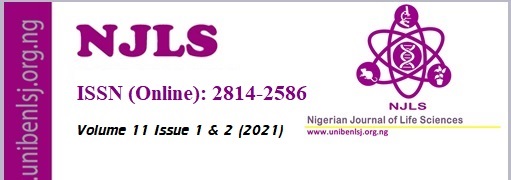Effect of Ethanol Leaf Extract of Simarouba glauca on Induced Dyslipidemia and Oxidative Stress
DOI:
https://doi.org/10.52417/njls.v11i1%20&%202.12Keywords:
Simarouba glauca; Wistar rats, Toxicity, Dyslipidemia, Oxidative stress.Abstract
Biologically active compounds with pharmacological potentials have been reported in Simarouba glauca; these compounds have shown interactions with biological molecules, hence this study. This study focused on long-term effect of ethanol leaf extract of Simarouba glauca (EESG) on lipoproteins and oxidative stress biomarkers in male Wistar rats. Oral administration of EESG was conducted according to the guidelines of organization for economic co-operation and development (OECD), No. 425 using a total of twenty-four (24) male Wistar rats, divided into four groups of six rats each. Test rats were given EESG at doses of 500, 1000 and 2000 mg/kg body weight respectively daily for thirty (30) days. At the end of the study, the rats were fasted overnight and sacrificed; relevant biochemical analyses were evaluated. Data were statistically analyzed with the Graphpad prism®, version 7. The data show marked reduction and increase (P ? 0.05) in HDL-cholesterol and TG respectively, at all doses; significant increase (P ? 0.05) in LDL-cholesterol at EESG 500 and 1000 mg/kg. Furthermore, the data obtained however indicated significant (P ? 0.05) elevation in heart MDA level at 500 mg/kg. The liver and kidney CAT activity were elevated (P ? 0.05) at EESG 1000 mg/kg; 500 and 2000 mg/kg respectively. Liver and Kidney SOD activity were elevated (P ? 0.05) at 2000 mg/kg, 500 and 1000 mg/kg respectively. The Liver GSH-PX was elevated (P ? 0.05) at 2000 mg/kg. The findings of the study showed that oral administration of EESG at high doses resulted to dyslipidemia. The marked increases in the endogenous defense enzyme system may have resulted from cytochrome P-450/NADPH Oxidase induced oxidative stress linked to xenobiotic metabolism.






